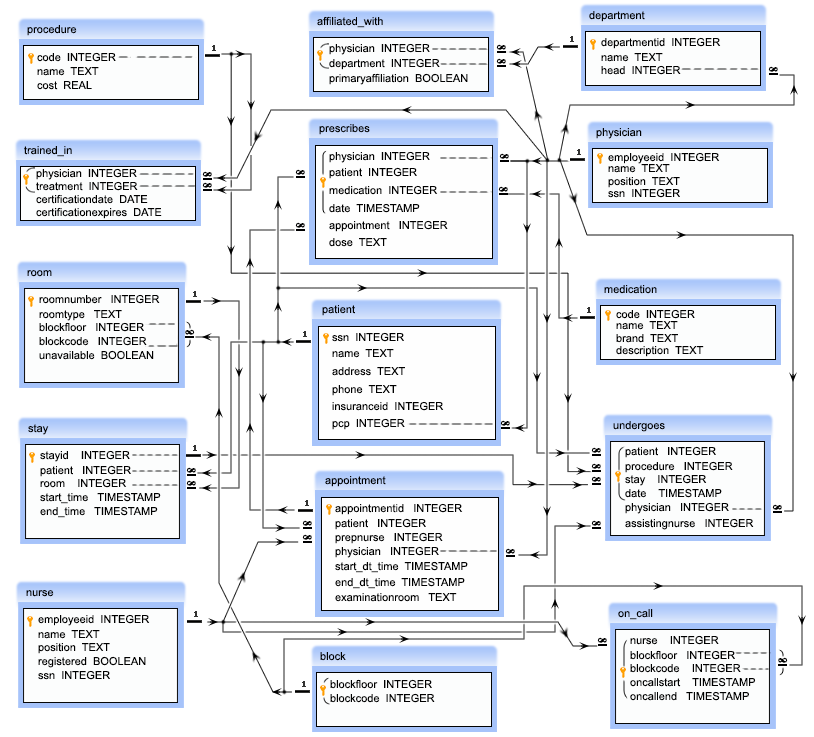SQL Exercise: Find nurses who have ever been on call for room 122
35. From the following table, write a SQL query to find out, which nurses have been on call for room 122 in the past. Return name of the nurses.
Sample table: nurse
employeeid | name | position | registered | ssn
------------+-----------------+------------+------------+-----------
101 | Carla Espinosa | Head Nurse | t | 111111110
102 | Laverne Roberts | Nurse | t | 222222220
103 | Paul Flowers | Nurse | f | 333333330
Sample table: on_call
nurse | blockfloor | blockcode | oncallstart | oncallend -------+------------+-----------+---------------------+--------------------- 101 | 1 | 1 | 2008-11-04 11:00:00 | 2008-11-04 19:00:00 101 | 1 | 2 | 2008-11-04 11:00:00 | 2008-11-04 19:00:00 102 | 1 | 3 | 2008-11-04 11:00:00 | 2008-11-04 19:00:00 103 | 1 | 1 | 2008-11-04 19:00:00 | 2008-11-05 03:00:00 103 | 1 | 2 | 2008-11-04 19:00:00 | 2008-11-05 03:00:00 103 | 1 | 3 | 2008-11-04 19:00:00 | 2008-11-05 03:00:00Sample table: room
roomnumber | roomtype | blockfloor | blockcode | unavailable
-----------+----------+------------+-----------+-------------
101 | Single | 1 | 1 | f
102 | Single | 1 | 1 | f
103 | Single | 1 | 1 | f
111 | Single | 1 | 2 | f
112 | Single | 1 | 2 | t
113 | Single | 1 | 2 | f
121 | Single | 1 | 3 | f
122 | Single | 1 | 3 | f
123 | Single | 1 | 3 | f
201 | Single | 2 | 1 | t
202 | Single | 2 | 1 | f
203 | Single | 2 | 1 | f
211 | Single | 2 | 2 | f
212 | Single | 2 | 2 | f
213 | Single | 2 | 2 | t
221 | Single | 2 | 3 | f
222 | Single | 2 | 3 | f
223 | Single | 2 | 3 | f
301 | Single | 3 | 1 | f
302 | Single | 3 | 1 | t
303 | Single | 3 | 1 | f
311 | Single | 3 | 2 | f
312 | Single | 3 | 2 | f
313 | Single | 3 | 2 | f
321 | Single | 3 | 3 | t
322 | Single | 3 | 3 | f
323 | Single | 3 | 3 | f
401 | Single | 4 | 1 | f
402 | Single | 4 | 1 | t
403 | Single | 4 | 1 | f
411 | Single | 4 | 2 | f
412 | Single | 4 | 2 | f
413 | Single | 4 | 2 | f
421 | Single | 4 | 3 | t
422 | Single | 4 | 3 | f
423 | Single | 4 | 3 | f
Sample Solution:
SELECT n.name
FROM nurse n
WHERE employeeid IN
( SELECT oc.nurse
FROM on_call oc,
room r
WHERE oc.blockfloor = r.blockfloor
AND oc.blockcode = r.blockcode
AND r.roomnumber = 122 );
Sample Output:
name
-----------------
Laverne Roberts
Paul Flowers
(2 rows)
Explanation:
The said query in SQL that selects the name of the nurse who is on-call for the same block and floor as room number 122.
In the subquery the nurse ID from the 'on_call' table, which stores information about nurses who are on call. A join builds with the 'room' table and 'on_call' table, to match the block and floor of the room number 122 with the corresponding block and floor of the nurse's on-call shift.
The outer query then selects the name of the nurse using the nurse's employee ID, which is found in the 'nurse' table.
The WHERE clause filters the nurse records based on whether their employee ID is in the list of nurse IDs returned by the subquery.
Go to:
PREV : Medical procedures done after certification expired.
NEXT : Patients who have been prescribed some medication.
Practice Online
E R Diagram of Hospital Database:
Have another way to solve this solution? Contribute your code (and comments) through Disqus.
What is the difficulty level of this exercise?
Test your Programming skills with w3resource's quiz.

